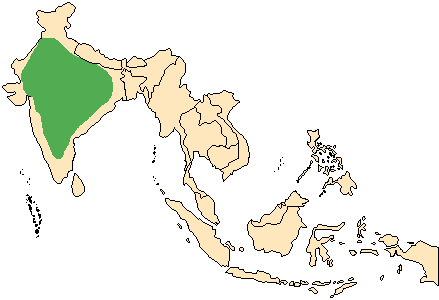![]() Return
to Artiodactyla
Return
to Artiodactyla
Classification
|
 Boselaphus
tragocamelus
Boselaphus
tragocamelus
Nilgai
![]()
Taxonomy
 |
 |
 |
Click on the pictures above for a larger view of the
photographs
|
||
General Characteristics
Body Length: 180-200 cm / 6-6.6 ft.
Shoulder Height: 120-150 cm / 4-5 ft.
Tail Length: 40-45 cm / 16-22 in.
Weight: 120-240 kg / 264-528 lb.The short coat is yellow-brown in females, and gradually turns blue-grey in males as they mature. There is an erectile mane on the nape and back and a "hair pennant" in the middle of the underside of the neck. There are white markings in the form of cheek spots, edges of the lips, and a throat bib. Along the underside is a thin white stripe, which "balloons" at the rear. The slender legs support a stocky body, which slopes downwards towards the rear. The head is long and slender. Males have 20-25 cm / 8-10 inch long horns which are straight and tilted slightly forwards.
Ontogeny and Reproduction
Gestation Period: About 8 months.
Young per Birth: Generally 2 (over 60% of births), sometimes 1 or 3.
Weaning: By 10 months.
Sexual Maturity: Around 18 months.
Life span: Up to 21 years.Breeding occurs throughout the year, but the peak of mating is December-March, with the resulting calves born in September and October.
Ecology and Behavior
The nilgai is mainly diurnal, with peaks in activity in the early morning and late afternoon. The sense of sight is well developed among this wary species. When chased, nilgai can run up to 48 kmph / 29 mph. Males have been observed to establish territories during the breeding season, attempting to gather and keep small herds of females (up to 10) within their area. Males compete with each other with threatening posture displays and neck wrestling, rarely leading to both rivals kneeling and lunging at each other with their horns. Normally silent, nilgai have been recorded making a roaring vocalization. The population density in central India is about 0.07 animals per square kilometer.Family group: Single sex or mixed herds of 4-20 individuals, old bulls may be solitary.
Diet: Leaves, buds, grasses, fruit.
Main Predators: Tiger, leopard, wolf, dhole.
Distribution
Grassy steppe and woodlands throughout India.

Range Map (Redrawn from Corbet and Hill, 1992)
Conservation Status
The nilgai is classified as a low risk, conservation dependent species by the IUCN (1996).
Remarks
Like the blackbuck, there are currently more nilgai living in a semi-wild state in Texas than in their native India, with estimated populations of 15,000 and 10,000 respectively. Nilgai is from the Hindustani word nil, meaning blue, and the Persian word gaw, meaning cow: a reference to the male's slate blue colouration. Bos (Latin) an ox; elaphos (Greek) a deer. Tragos (Greek) a he-goat; kamelos (Greek) a camel. This odd combination of names is probably on account of the nilgai's strange mixture of characteristics.
Literature Cited
Corbet, G. B., and J. E. Hill. 1992. The Mammals of the Indomalayan Region: A systematic review. Oxford: Oxford University Press.Nowak, R. M. [editor]. 1991. Walker's Mammals of the World (Fifth Edition). Baltimore: The Johns Hopkins University Press.
Walther, F. R. 1990. Spiral-horned antelopes. In Grzimek's Encyclopedia of Mammals. Edited by S. P. Parker. New York: McGraw-Hill. Volume 5, pp. 344-359.
Wilson, D. E., and D. M. Reeder [editors]. 1993. Mammal Species of the World (Second Edition). Washington: Smithsonian Institution Press. Available online at http://nmnhwww.si.edu/msw/
Return to Artiodactyla

![]()
© Brent Huffman, www.ultimateungulate.com |
|
|